Methods of Torture and Execution
Written by Clive "James" Python, 2017-12-15Humans are the smartest animals on Earth; we have invented millions of life-changing inventions such as the telephone, hospitals, time and most importantly, the World Wide Web. Man has made amazing progress compared with any other animal on this planet made out of dirt and water.
Torturing and executing people is really nothing new; it's been around since pre-history, it's really not a surprise that there have managed to make new and sickening ways to bring pain to others we see fit to.
The Iron Maiden
Who hasn't heard of the iron maiden at one point in their life or another? It's maybe one of the most well-known devices of torture and execution, however, as you will soon find out, its legitimacy was unknown...
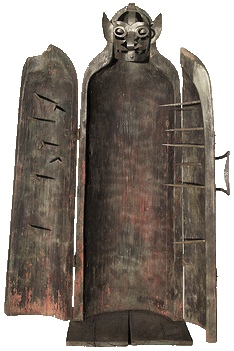 The iron maiden is an upright sarcophagus-like device that has spikes on the
inner surfaces, with double doors that open on the front that allow an entrance
for the victim-to-be, once the unlucky victim was inside the maiden, the doors
would be shut. The second the doors are shut, spikes would pierce several vital
organs, however, because the spikes were relatively short, they wouldn't
instantly fatal, instead, the victim would linger and bleed to death over
several hours. To add insult to injury, two spikes were positioned specifically
to penetrate the eyes. Ow.
The iron maiden is an upright sarcophagus-like device that has spikes on the
inner surfaces, with double doors that open on the front that allow an entrance
for the victim-to-be, once the unlucky victim was inside the maiden, the doors
would be shut. The second the doors are shut, spikes would pierce several vital
organs, however, because the spikes were relatively short, they wouldn't
instantly fatal, instead, the victim would linger and bleed to death over
several hours. To add insult to injury, two spikes were positioned specifically
to penetrate the eyes. Ow.
For a long time, the iron maiden's legitimacy was debated, until in the 1800s when researchers found one in a castle in Nuremberg, Germany and documented proof of its use later surfaced. For this reason, this device is sometimes known as "The Iron Maiden of Nuremberg", other names for it include "The Virgin" (hitting too close to home there) and in Germany, it is known as "Jungfer".
A variation found in Spain was made to look like the Virgin Mary and had machinery that, when manipulated, caused her to "hug" the victim close to her spikes.
Of cause, it's hard to talk about the iron maiden without bringing up the English heavy metal band formed in Leyton, East London, in 1975 that have the same namesake. Iron Maiden are best known for their song "The Number Of The Beast". Iron Maiden have managed to grab a large number of awards and nominations, such as a 2009 BRIT Awards for Best British Live Act, a 2011 Grammy Award for Best Metal Performance and a 2015 Best International Live Act from the Bandit Rock Awards. A fair bit of warning, if you or anyone you know does intend to play any Iron Maiden, it is recommended to play it as loud as possible.
The Pear of Anguish
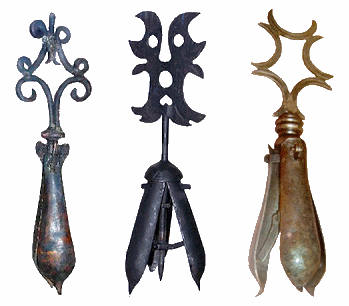 The pear of anguish, also known as the choke pear, is a pear-shaped device, with
the body of the pear made up of four metal "leaves" joined by a hinge at its
top and a key or crank on one end. The idea of the device would be inserted
into the vagina, anus or throat, depending on the nature of the crime
committed; if you were found guilty of being a heretics, the pear would be
inserted orally, while the anal and vaginal pears were used on homosexuals and
witches, respectively. Turning the key opened the leaves, causing massive
internal damage. The device was rarely fatal, but other methods of torture
would usually follow...
The pear of anguish, also known as the choke pear, is a pear-shaped device, with
the body of the pear made up of four metal "leaves" joined by a hinge at its
top and a key or crank on one end. The idea of the device would be inserted
into the vagina, anus or throat, depending on the nature of the crime
committed; if you were found guilty of being a heretics, the pear would be
inserted orally, while the anal and vaginal pears were used on homosexuals and
witches, respectively. Turning the key opened the leaves, causing massive
internal damage. The device was rarely fatal, but other methods of torture
would usually follow...
There is no contemporary first-hand account of the device being used, however, through the design of the devices, such as metal consistency and style, these are often dated to the early modern period (c. 1600). An early mention is in F. de Calvi's L'Inventaire général de l'histoire des larrons (" General inventory of the history of thieves"), written in 1639, which attributes the invention to a robber named Capitaine Gaucherou de Palioly in the days of Henry of Navarre. Palioly would have used a mechanical gag to subdue a wealthy Parisian while he and his accomplices robbed the victim's home.
Thumbscrews
The thumbscrew is a torture first used in medieval Europe, it is a basic vice and sometimes has protruding studs on the interior surfaces. The victims' thumbs, fingers, or toes would be placed in the vice and slowly crushed. The thumbscrew was also applied to crush prisoners' big toes. The crushing bars were sometimes lined with sharp metal points to puncture the thumbs and inflict greater pain in the nail beds. Larger, heavier devices based on the same design principle were applied to crush feet.
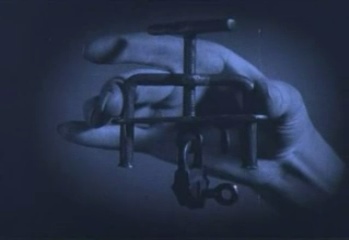 Cochrane and McCrone, somewhat wryly, argue that the thumbscrew entered the
British Isles later than the invasion of the Spanish Armada in the 16th
century:
Cochrane and McCrone, somewhat wryly, argue that the thumbscrew entered the
British Isles later than the invasion of the Spanish Armada in the 16th
century:
"It has been very generally asserted," says Dr. Jamieson, "that part of the cargo of the invincible Armada was a large assortment of thumbikens, which it was meant should be employed as powerful arguments for convincing the heretics." The country of the inquisition was certainly a fit quarter from whence to derive so congenial an instrument; but other accounts, as we have said, and these apparently unquestionable, assign it a later introduction... In the torturing of [William] Spence, Lord Fountainhall mentions the origin of the thumbikens, stating that this instrument "was a new invention used among the colliers upon transgressors, and discovered by Generals Dalyell and Drummond, they having seen them used in Muscovy." The account of Bishop Burnet gives of the torturing of Spence confirms the then recent use of the thumbikens. ... This point we think is put beyond all doubt by the following act of the privy council in 1684, quoted in Wodrow's invaluable history: "Whereas there is now a new invention and engine called the thumbikens ... the Lords of His Majesty's Council do therefore ordain, that when any person shall be put to the torture, that the boots and the thumbikens both be applied to them..."
The Brazen Bull
The brazen bull, also known as the bronze bull and the Sicilian bull, was a
torture and execution device designed in ancient Greece. According to Greek
historian, Diodorus Siculus, recounting the story in Bibliotheca historica,
Perillos of Athens invented and proposed it to Phalaris, the tyrant of Akragas,
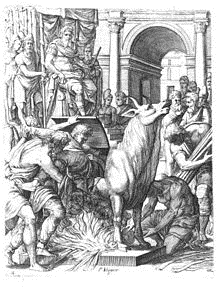 Sicily, as a new means of executing criminals. The bull was made entirely out
of bronze, hollow, with a door on one side. As the name suggests, the bull was
in the shape and size actual bull and had an acoustic apparatus that converted
screams into the sound of a bull. The condemned were locked inside the device,
and a fire was set under it, heating the metal until the person inside was
roasted to death.
Sicily, as a new means of executing criminals. The bull was made entirely out
of bronze, hollow, with a door on one side. As the name suggests, the bull was
in the shape and size actual bull and had an acoustic apparatus that converted
screams into the sound of a bull. The condemned were locked inside the device,
and a fire was set under it, heating the metal until the person inside was
roasted to death.
Phalaris commanded that the bull is designed in such a way that its smoke rose in spicy clouds of incense. The head of the bull was designed with a complex system of tubes and stops so that the prisoner's screams were converted into sounds like the bellowing of an infuriated bull. According to legend, when the bull was reopened, the victim's scorched bones "shone like jewels and were made into bracelets."
Perillos said to Phalaris: "His screams will come to you through the pipes as the tenderest, most pathetic, most melodious of bellowings." Perillos believed he would receive a reward for his invention. Instead, Phalaris, who was disgusted by these words, ordered its horn sound system to be tested on Perillos himself. When Perillos entered, he was immediately locked in and the fire was set, so that Phalaris could hear the sound of his screams. Before Perillos could die, Phalaris opened the door and took him away. After freeing him from the bull, Phalaris took Perillos to the top of a hill and threw him off, killing him. Phalaris himself is said to have been killed in the brazen bull when he was overthrown by Telemachus, the ancestor of Theron.
Pindar, who lived less than a century afterwards, expressly associates this instrument of torture with the name of the tyrant Phalaris.
The Romans were reported to have used the brazen bull as a way to kill some Christians, notably Saint Eustace, who, according to Christian tradition, was roasted in a brazen bull with his wife and children by Emperor Hadrian. The same fate happened to Saint Antipas, Bishop of Pergamon during the persecutions of Emperor Domitian and the first martyr in Asia Minor, who was roasted to death in a brazen bull in AD 92. The device was still in use two centuries later, when another Christian, Pelagia of Tarsus, is said to have been burned in one in 287 by Emperor Diocletian.
The Catholic Church discounts the story of Saint Eustace's death as "completely false".
The Iron Chair
The Iron Chair was a torture device that was used extensively during 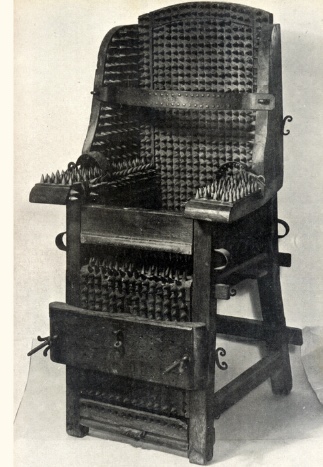 The Middle Ages. A Victim would be placed onto the chair - which featured
hundreds of sharp spikes - The victim's wrists would be tied to the chair or
bars pushed the arms against arm-rests for the spikes to penetrate the flesh
even further.
The Middle Ages. A Victim would be placed onto the chair - which featured
hundreds of sharp spikes - The victim's wrists would be tied to the chair or
bars pushed the arms against arm-rests for the spikes to penetrate the flesh
even further.
Because the chair was made from iron, it can also contain spaces for heating elements beneath the seat.
This could go on for hours, even days. Because of where the spikes were placed, they did not penetrate vital organs and blood loss was minimized - or at least until the person was released from the chair. Death would often follow.
The Iron Chair was often used as a psychological instrument of torture; victims would often confess after being forced to watch other prisoners being tortured by the device.
It was used until the 1800s in Europe.
Ducking Stool
Ducking was a form of punishment that was mainly reserved for supposed "witches". The victim would be tied down to a chair and elevated by ropes above a pond, river, or any body of water. The "witch" would be lowered into the water until completely submerged. The chair could be raised if the victim was about to pass out, or to give the victim a chance to "confess".
If the victim confessed they would be executed, so it's really a lose-lose for them. Ducking was widely used during the Spanish Inquisition and in England and France. It was also used at the Salem Witch Trials in New England, where victims were subjected to varying lengths of time and levels of submersion. The victim was intermittently submerged for hours until they confessed, revealed information or drowned.
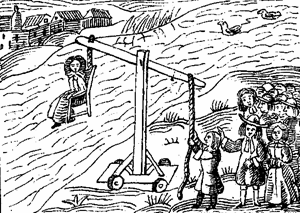
While "witches" were commonly tortured using this method, thieves and murderers could be subjected to it in order to extract a confession. This was more common when other more sophisticated torture devices were not available.
Ducking or dunking was also used as punishment for common scolds.
References
I. The photo of the iron Maiden
https://horrorpedia.com/2015/03/08/iron-maiden-torture-device/ [Internet Archive, archive.is
II. Methods of Torture and Execution
https://imgur.com/a/DJXhN [Internet Archive, archive.is]
III. List of awards and nominations received by Iron Maiden
https://en.wikipedia.org/wiki/List_of_awards_and_nominations_received_by_Iron_Maiden [Internet Archive, archive.is]
IV. Pear of anguish
https://en.wikipedia.org/wiki/Pear_of_anguish [Internet Archive, archive.is]
V. Thumbscrew (torture)
https://en.wikipedia.org/wiki/Thumbscrew_(torture) [Internet Archive, archive.is]
VI. The photo of the thumbscrew is from "Häxan: Witchcraft Through the Ages" (1922, Public Domain)
https://owlman.neocities.org/library/haxan.html [Internet Archive, archive.is]
VII. Brazen bull
https://en.wikipedia.org/wiki/Brazen_bull [Internet Archive, archive.is]
VIII. Medieval Torture
http://www.medievalwarfare.info/torture.htm [Internet Archive, archive.is]